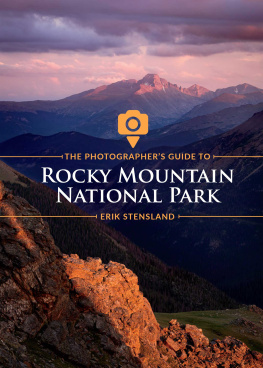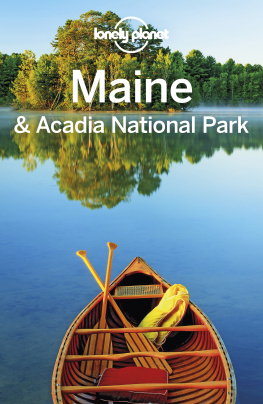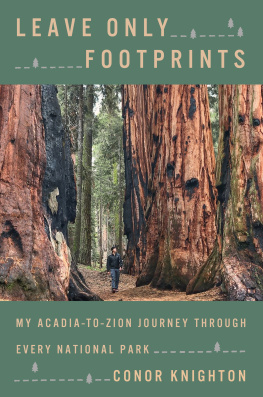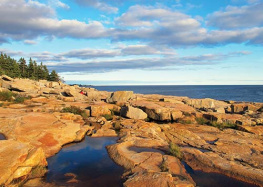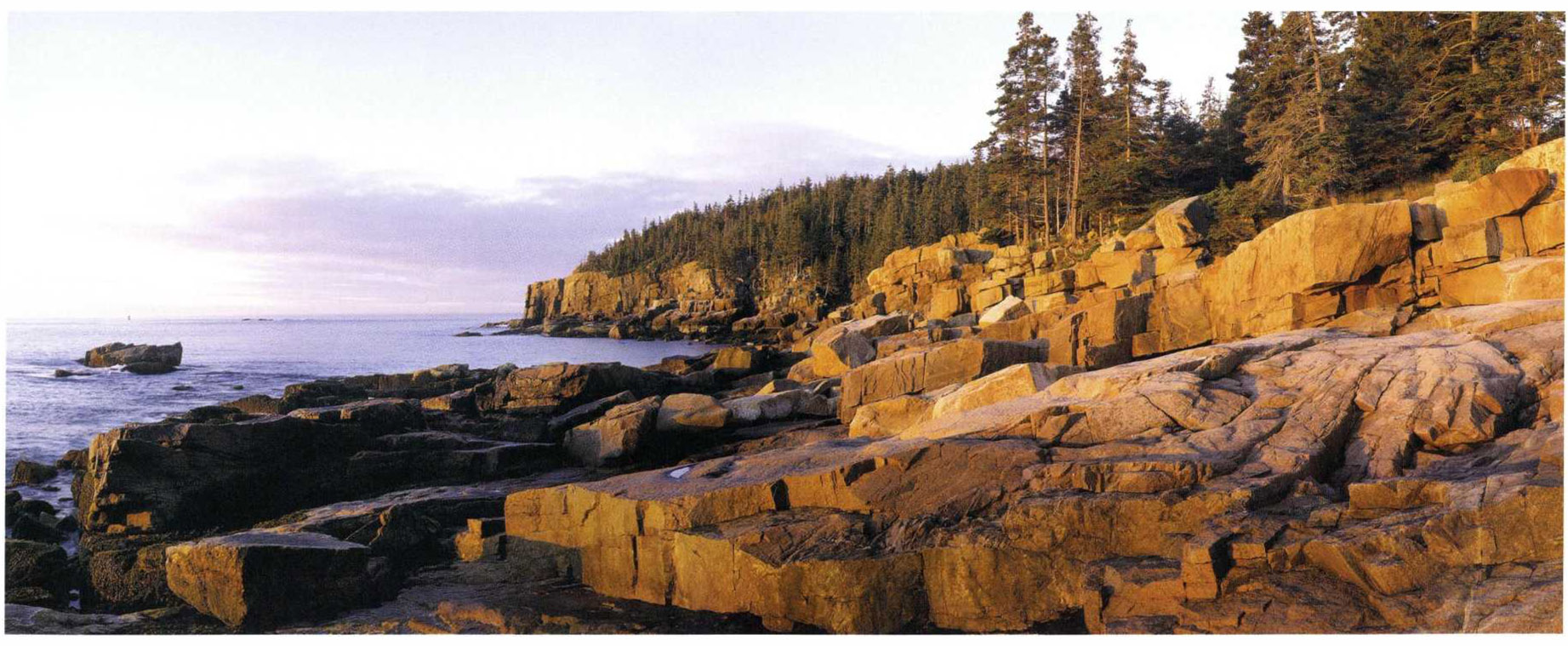Copyright 2008 by Alan Nyiri. All rights reserved.
ISBN 978-0-89272-740-7
Page layout: Down East Enterprise
Printed in China
www.nbnbooks.com
Distributed by
National Book Network
800-462-6420
Library of Congress Cataloging-in-Publication Data
Nyiri, Alan.
Acadia panorama: images of Maines national park / Alan Nyiri.
p. cm.
ISBN 978-0-89272-740-7 (trade pbk. : alk. paper)
1. Acadia National Park (Me.)--Pictorial works. 2. Natural history-Maine--Acadia National Park--Pictorial works. I. Title.
F27.M9N95 2008
917.41'4500222--dc22 2007041833
Images in this book are available as archival fine-art gicie prints.
Please visit my website at www.alannyiri.com for details.
For Angele, my paddling partner in life. Whether the seas are stormy or calm, you are always there, sometimes lending support and sometimes leading the way.
ACADIA
PANORAMA
Introduction
Anticipation
Id never seen anything quite like it. Clouds started to stream in from the northwest around ten oclock on Tuesday morning, and continued all day. What made them so unusual was that they remained in a very tight band with an unwavering edge all afternoon, moving neither east nor west of their line. By evening, they expanded all the way to the western horizon, blocking the sunset, yet the eastern edge had scarcely budged, still marking a clearly defined line about 45 degrees above the horizon. Some air mass was fixed there like an invisible guardrail on this weather fronts highway.
If this pattern held through the night, these alto-cumulus clouds could provide a magnificent sunrise. Now, sunrise/sunset images have been so overdone as to go beyond clich, and while I no longer make any special effort to photograph one, I do always try to be outdoors to enjoy the event. However, the potential of Wednesdays daybreak was so strong that I loaded my cameras with film and set my alarm for three-thirtymidsummer sunrise comes very early to coastal Maine.
I could hardly believe my eyes when I awoke. The clouds had held their position through the night, and below them, to the east, the faintest pre-dawn glow was visible. Grabbing a quick cup of coffee and an apple, I jumped in my truck and headed for Cadillac Mountain.
By four oclock the eastern horizon was showing strong early color, already as vivid as many a sunrise ever gets. Ive seen many seemingly promising situations fizzleevery photographer hasbut now I really believed that a spectacular sunrise was about to occur. Having already determined my best vantage point the evening before, all I had to do now was set up my tripod and camera, unpack my backup gear, and wait for the main attraction.
Preparationand Luck
Its extremely satisfying when light, weather, and location merge to produce a scene beyond your wildest dreamsand youre there, ready to record the moment, ready to make images. I wish that I could say that it always happens this way: careful observation leads to a previsualized inspiration, and thorough planning is rewarded with a wonderful image. But of course I cant say that. More often, its just plain dumb luck that sets the stage. I was exploring the Otter Cliffs area one morning, watching small rain showers marching down Frenchman Bay in the distance and looking for an interesting foreground in case something exciting happened with the wearher. I was working halfway down the rock face and the cliffs above obscured the sky to my west, so I didnt see the approaching shower until the first few raindrops alerted me. I hastily covered my camera and put on my poncho, and while other people scurried back to the protection of their cars, I waited out the shower to see what might happen. The brief deluge soon passed, and as I watched the shower move east past Schoodic Point, it occurred to me the strongest visual composition here might be just ocean, shower, and surrounding clouds, with no foreground at all. Anticipation and preparation are the most important tools I carry with me. Anticipation starts with observation: Whats happening around me right now? Next comes speculation: Whats likely to develop seconds, minutes, or hours from now as events play themselves out? Then comes preparation: If events occur as expected, where do I want to be and what do I need to have on hand? And if something else happens, what are my backup plans? Serendipity isnt just about luck. People who are habitually in the right place at the right time are very likely there because they anticipated correctly, or were at least expectant and prepared.

From Vision to Print
I have been using panoramic cameras for ten years now, and have found that the landscapes and seascapes found along the down east coast seem especially well suited to the wide-format interpretation. The extremely wide format is especially challenging. Everything in an image must be interesting to look at and must contribute to the flow of energy within the compositiona goal difficult enough to achieve even with the familiar rectangular-format camera.
The Noblex cameras I use capture a full 140-degree panoramic viewthis approximately matches most peoples peripheral vision. Many so-called panoramic cameras make a 90- to 105-degree image and trim off the top and bottom to create the wide format. With a revolving lens and a curved film plane that matches the arc of the turning lens, the Noblex creates an image that is consistently sharp from corner to corner. Its been a thoroughly satisfying tool for panoramic work.
The non-panoramic images in this collection were made with a 4 5 Sinar monorail camera adapted for field use, and a variety of Schneider and Nikon lenses. I use Kodak Ektachrome film exclusivelyI value its consistency and predictability and appreciate its palette.
In past book projects Ive had to turn my films over to the prepress people with some interpretive directions and hope for the best. To their credit, they usually did an excellent job. Acadia Panorama was prepared differently: I made my own high-resolution digital scans and refined each image using Photoshop until I felt it presented all of the nuances of color, contrast, and mood that I had previsualized when making the images. This unprecedented amount of artistic control allows me to feel confident about the fidelity of these book images to both my original vision and my photographic prints.
This ability to remaster these digital scans also allows me to compensate for the fact that even the finest book reproductions can represent only a tiny fraction of the visual range we perceive when we view a scene directly. While I cannot change the dynamic characteristics of photographic film, book paper, or printers ink, I can partially compensate for their limitations by adjusting the digital profile of each image. This involves more than just pumping up the color saturation, as seen so often now in calendars and magazines. By making fine adjustments to the color, contrast, and tonal range of these scans, I am able to approximate the psychological impression of the original scene and recreate my artistic intent.
Next page


